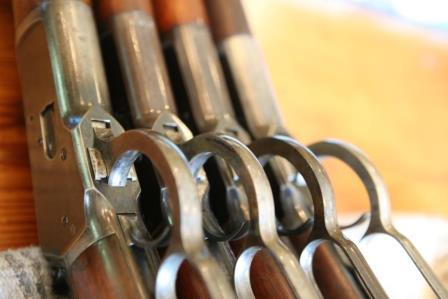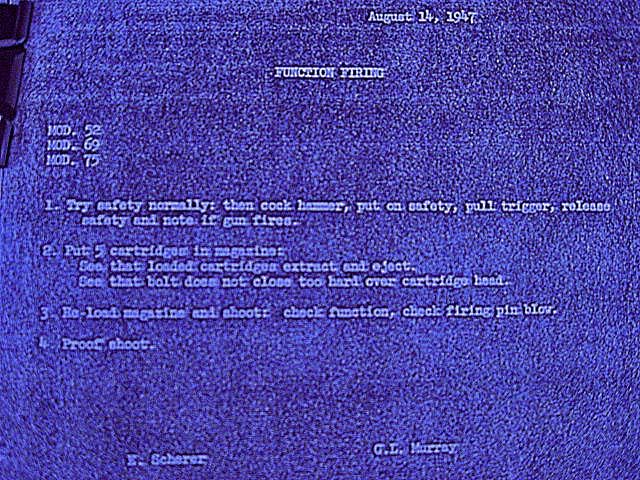September 9, 2008
 Offline
OfflineIn recently bought my first Winchester lever gun. I have had M70’s (pre 64) for a long time but not a lever. As ammo is VERY hard to find I want to load for this but the relatively scarce data I’m finding shows a 255gr bullet at 1700 fps or more. My rifle is in good condition and has a good bore but this velocity seems a bit steep to me. What would be a safe pressure and velocity to be looking at? I shoot a lot of Damascus barreled shotguns so low pressure moderate velocity isn’t new to me.
April 15, 2005
 Offline
OfflineRich,
1700 fps is a bit stout for the 38-55 cartridge.
Per the Winchester 1900 catalog, 1,285 fps was the standard velocity for the 255-gr bullet
Per the Winchester 1905 catalog, 1,285 fps was the standard velocity for the 255-gr bullet, and 1,550 fps was standard for the 255-gr W.H.V. load.
Per the Winchester 1911 catalog, the standard load was increased to 1,321 fps, and the W.H.V. load was increased to 1,593.3 fps.
If it were me, I would keep the velocity under 1,600 fps.
Bert
WACA Historian & Board of Director Member #6571L

October 19, 2013
 Offline
OfflineMike I believe you will find the action on the Model 1894 is
quite strong enough for the 38-55 at 1700 fps it was designed
for the new smokeless powder to come. the early barrels however
were still of the softer steel as Bert mentioned earlier around 1910
Winchester was offering the 38-55 WHV at nearly 1600fps and as
early as 1905 Marlin was offering the 38-55 HPS with the 255 gr
bullet at 1700fps for their Model 1893 but they also strongly
advised against shooting the HPS ammo in the older guns designed
for blackpowder with all this being said I do agree that one should
keep the loads in these guns to the lower levels GJ
March 19, 2014
 Offline
OfflineTo me those kinds of velocities in the 1894 as originally designed are excessive. They are in the ballpark with the .375 Winchester that the 94 Big Bore was created for. You will notice the receiver walls where the Big Bore locking lugs are have been beefed up considerably.
June 11, 2014
 Offline
OfflineI have had a variety of original Winchester Model 1894’s chambered in 38-55 and have done a lot of reloading for them. Bert’s data is an important benchmark when it comes to developing safe loads. I have experimented a bit with High Velocity loads but nothing over 1,600 fps and those were achieved with the relatively slower burning IMR 3031. Now, I stick to velocities around 1,300 fps with a cast 262 grain bullet and using 5744. Here is my pet load for the 38-55 http://forum.winchestercollector.org/viewtopic.php?t=6770 This load will go right through a Whitetail buck, no problem, and I shoot it out to 200 yards.
May 23, 2009
 Offline
OfflineJust curious to know, if anyone here does, What would the velocity of a Factory Proof Load be? That is If I recall correctly Proof Loads were potent 30-60% more than the standard Factory Load. Wouldn’t it exceed 1,700 fps?
Sincerely,
Maverick
![]()
WACA #8783 - Checkout my Reloading Tool Survey!
https://winchestercollector.org/forum/winchester-research-surveys/winchester-reloading-tool-survey/
April 15, 2005
 Offline
OfflineThe following is quoted from the April 1900 Winchester catalog No. 65…
"[color=blue:1a4792d5c8]The proof is made as follows: The barrel is locked to a firing table, loaded with a charge of powder and lead twice as great as intended to be put into the shell the barrel is to be chambered for, and fired. It is then carefully inspected and if the barrel shows the slightest sign of strain, or imperfection, it is condemned.[/color:1a4792d5c8]"
I do not know what velocity a 200% charge of powder would generate for a 510-grain slug of lead, but I can imagine that the pressure would be significantly higher. Regardless of what the numbers are, it would be foolish to fire proof loads on a repeated basis. It really is not the actual fps that is critical. Instead, it is the pressure needed to achieve the velocity that is critical.
Bert
WACA Historian & Board of Director Member #6571L

June 11, 2014
 Offline
OfflineBert, does the information specify whether that proof method is for black powder or for smokeless? I can see that method as doable for black powder but a double charge of smokeless will usually blow even a modern steel rifle, especially if the bullet weight is doubled as well.
I agree that it would be foolish to fire proof loads repeatedly. I personally know a fellow who blew up a high condition original Model 1886 by repeatedly firing fairly stiff loads through it. The rifle handled the first few hundred and then finally let go.
September 9, 2008
 Offline
OfflineEverything about this caliber seems hard to find from reloading data (I appreciate all the help that’s come from this forum), loaded ammo, empty brass even bullets are scarce. I have been told Winchester makes a limited run of ammo once a year and when they do I’ll have to buy several boxes. I know they do this limited run on brass as I had to wait for brass for my 358 to get started loading that.
March 20, 2009
 Offline
OfflineBert posted:
The barrel is locked to a firing table, loaded with a charge of powder and lead twice as great as intended
Looking for a little clarification here. Was it just the barrel or the final assembled rifle which was tested? And, Is there really room in a cartridge for a bullet twice the weight/length and twice as much powder?
Michael

Model 1892 / Model 61 Collector, Research, Valuation
July 17, 2012
 Offline
Offlinetwobit said
Bert posted:The barrel is locked to a firing table, loaded with a charge of powder and lead twice as great as intended
Looking for a little clarification here. Was it just the barrel or the final assembled rifle which was tested? And, Is there really room in a cartridge for a bullet twice the weight/length and twice as much powder?
Michael
I don’t know about the centerfire rifles but the rimfires were proof fired as complete rifles. The Winchester documents for the bolt action repeaters stated they were test fired and then proof fired.
Regards,
WACA Life Member #6284 - Specializing in Pre-64 Winchester .22 Rimfire
April 15, 2005
 Offline
Offlinetwobit said
Bert posted:The barrel is locked to a firing table, loaded with a charge of powder and lead twice as great as intended
Looking for a little clarification here. Was it just the barrel or the final assembled rifle which was tested? And, Is there really room in a cartridge for a bullet twice the weight/length and twice as much powder?
Michael
Michael,
I interpret it as just the barrel being locked to a firing table, and it was not loaded with a cartridge per se.
I simply quoted exactly what Winchester published in their turn of the century catalogs.
Bert
WACA Historian & Board of Director Member #6571L

December 30, 2011
 Offline
Offlinetwobit said
Bert posted:The barrel is locked to a firing table, loaded with a charge of powder and lead twice as great as intended
Looking for a little clarification here. Was it just the barrel or the final assembled rifle which was tested? And, Is there really room in a cartridge for a bullet twice the weight/length and twice as much powder?
Michael
Michael
I’ve looked through some catalogs about this subject and the definition of the testing changed at least once or twice. In 1920 they describe testing the barrel initially with a "powder charge two and a half times that for which it is intended, and a bullet one-third heavier" "Winchester barrels have passed this test for more than 50 years" although they used the definition Bert described in earlier catalogs.
In the 1920 catalog they also followed up with the "Definitive Proof Test" with a charge 25 to 40 percent more than standard and this was done after the rifle was assembled, according to the catalog, and then the iconic WP was stamped if it passed.
This is what it says in the catalog. All I’m doing is repeating it for you. Obviously I have no idea what they really did and when. I get the feeling there were people that wrote the catalogs and did the marketing and there were the people that built the firearms….
Brad
May 23, 2009
 Offline
OfflineI have a feeling the catalogs may have exaggerated some on how the proof loads were made but then again maybe not. In 1895 Winchester began loading cartridges for smokeless powders. So by 1900 I imagine the catalog maybe referring to smokeless but then again maybe not as winchester offered both loadings in smokeless and black powder for many years.
Curious to know if there are any cartridge collectors in the association that possess factory Proof Loaded boxes. And if they have any knowledge there of. I supposed my point was that if the gun would with stand the shooting of Proof Loads, then slightly above standard loading maybe possible, even if inadvisable to do so. I suppose you take a chance ever time you shoot a collectible firearm anyway. But like Bert I don’t believe you should go around shooting proof loads every day.
Sincerely,
Maverick
![]()
WACA #8783 - Checkout my Reloading Tool Survey!
https://winchestercollector.org/forum/winchester-research-surveys/winchester-reloading-tool-survey/
December 30, 2011
 Offline
OfflineI have a feeling the catalogs may have exaggerated some on how the proof loads were made but then again maybe not. In 1895 Winchester began loading cartridges for smokeless powders. So by 1900 I imagine the catalog maybe referring to smokeless but then again maybe not as winchester offered both loadings in smokeless and black powder for many years.
Maverick
I’m reading a catalog description of barrel testing similar to that which Bert cited. They say they tested both black powder in "soft steel…with a charge of powder and lead twice as great as is intended". Nickel steel was "subjected to a pressure 30 percent in excess of pressure developed by the cartridge the barrel is intended to be chambered for" with smokeless powder. That’s what they say in 1903. Maybe they just updated the catalog text sometime between 1900 and 1903, but likely had been testing nickel steel barrels and smokeless powder in this method for awhile?
Brad


 Log In
Log In







